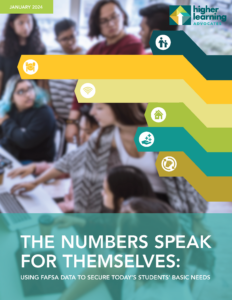Numbers Speak
Basic needs insecurity adversely affects students’ well-being, as well as their college persistence and completion. Research shows that food and housing insecurity are contributing factors to lower graduation rates. Higher education funding alone is not enough to meet those needs.
One solution is to ensure students access all available financial support, including means tested public benefits such as SNAP (the Supplemental Nutrition Assistance Program), subsidized health insurance, broadband assistance, and tax credits. Millions of college students are eligible for such benefits, however, they are unaware of their eligibility or do not know how to apply. For instance, roughly 2 million students who are eligible for SNAP do not participate, leaving around $3 billion in benefits on the table.
Are Institutions Conducting Outreach to Students?
HLA and the National Association of Student Financial Aid Administrators (NASFAA) conducted research on how institutions of higher education (IHEs) are using the Free Application for Federal Student Aid (FAFSA) data to alert students of their potential eligibility for benefits. The new survey research, presented throughout HLA and NASFAA’s brief, The Numbers Speak for Themselves: Using FAFSA Data to Secure Today’s Students’ Basic Needs, followed the Department of Education’s (ED’s) effort to address students’ basic needs insecurity in January 2022.
In March 2023, NASFAA distributed an electronic survey to its primary contacts at its member institutions. Of the 2,638 IHEs that received the survey, 275 submitted completed surveys and 84 provided at least one response, for a total of 359 (13%) survey respondents. The data were analyzed through quantitative and qualitative methods.
Some findings from our survey of institutions include:
- Just over 25% of respondents are currently conducting direct outreach to students about any federal benefit programs with or without using FAFSA data
- An additional 18% have plans to conduct outreach, but 43% do not and have no plans of doing so
- The most popular programs for conducting targeted outreach using FAFSA data included SNAP and the Affordable Connectivity Program (ACP) at 85% and 64%, respectively
- Fewer than 20% of respondents reported using FAFSA data to conduct direct outreach about the health insurance available under the Affordable Care Act or the Child Tax Credit
- Only 14% of institutions share data directly with county or state agencies – an activity ED explicitly endorses
For more findings, read The Numbers Speak for Themselves: Using FAFSA Data to Secure Today’s Students Basic Needs and HLA’s federal policy recommendations based on the new research presented in our brief.
Download the survey brief here
![]()
Students are failing out of college due to a lack of support and basic needs. People are not thinking holistically.
– Linda Williams, Financial Aid Administrator, Sierra College (CA)
Related Resources
Please find the related resources to the post above.
-
Policy Recommendations
Recommendations to increase access to means-tested public benefits in postsecondary education -
Numbers Speak slide deck
Use the slide deck to present the survey brief's research -
Back to Basics Policy Toolkit
A basic needs policy toolkit for today’s students to succeed

